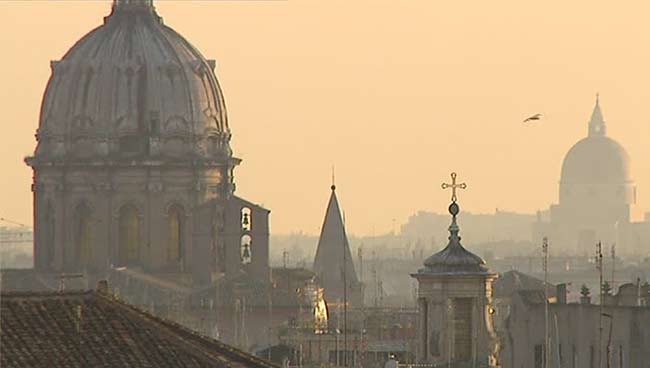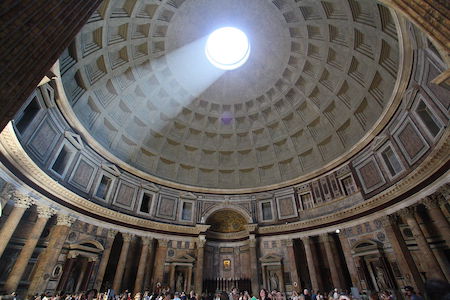
Roman Variations
A work in progress – by Patricia Vigderman
When I began writing about Rome, I was pulling on a loose thread, only half aware of what it might unravel. In clumsy courtship of an enduring and capacious city, I kept going back again and again, pursuing intimacy among the ravages and riches of Rome’s past. That adventure ended at the edge of a global pandemic. Within a distant mirror, then, was spun a web of connection, crisscrossed by the filaments of previous travelers: a web to catch a city already caught in time’s capacious net.

I’d wanted to see the Pantheon in the rain; I couldn’t quite believe that spacious marvel of measurement really truly was open to the sky. On clear days the motion across the floor of the sunlight through the oculus connects heaven’s beneficence to the works of men. But heaven has other faces. How would this magnificent creation keep its imperial aplomb when the skies opened, making a complete mess of the streets we were hustling through, every shop front lined with people huddling in an untidy melee?
The sheltering porch of the Pantheon was packed, a damp murmur all around, but when we made our way inside and I lifted my eyes, there indeed was the steady fall of the rain, a lovely luminous veil under the round opening to the sky, falling lightly into the immense bowl of the space as if sure of its welcome, as if it were grace itself. The crowd shifted easily around it, leaving clear the place on the wide marble floor beneath the light as if to honor the shower from above. And the light fell into this shelter, where the opulence on the walls, carved and polished by master craftsmen, displays the colors of geological time. Here were no columns scavenged from the past, no song of praise, no golden tale of everlasting life. Instead, water and light entered as one: fell from the open dome as heaven’s steady, unstinting gift.
❁
Twice I’ve joined little gyms in Rome’s Monteverde neighborhood, two different ones because (as I was not surprised to discover) the first one was out of business when I returned fifteen months later. That first palestra, on viale dei Quattro Venti, had been about a tenth the size of the gym I belong to at home. Along one wall of the women’s changing room were four flimsy little showers; in the main area a dozen exercise machines were crammed together; all the freeweights seemed to be in odd metric denominations to be deciphered only by hefting them. But when I signed up, the linguistic comedy of my inscription there was warm and inviting. The one member using the place at the time had been a portly old fellow seated with a weight in one hand.
“Professore,” called the woman at the desk, “lei parla Inglese, si?” He paused in his lifting. “Non assai bello,” he replied, not so beautifully, but he came over and with his unbeautiful English (almost learned at university, fifty forgotten years previously) and my halting Italian (the same) our three-way dialog turned into my successful welcome onto the premises. To satisfy their hygiene requirements I acquired a pair of gym shoes for five euros; it wasn’t clear which shoe went on which foot, but they were perfectly adequate to use on the single elliptical machine. As I stomped my way through my workout I could see out the front door into the alleyway, where the woman who presided at the desk (although I also saw her occasionally working as a trainer) had stepped out to enjoy a cigarette.
Quattro Venti Fitness having vanished when I next returned, I turned up a gym a bit farther away called Vascello Fitness, the vascello in question not in fact an actual boat but the nickname of a famous, once grand palazzo nearby. The situation was similar (down an alleyway, exercise and weight machines set up in close proximity, showers and changing facility a testimony to the national talent for wresting utility from every inch), but the management seemed less haphazard, and the establishment less likely to be swept overboard. A loudspeaker broadcast a continuous stream of American pop and Italian commercials from a radio station apparently stuck somewhere between 1950 and 1975.
The walk down the hill and back became part of my workout: descending from the Porta Pancrazio along a narrow sidewalk, where a railing protected pedestrians from the mad charge of little cars up the hill. Then across a precarious triangle onto via Fonteiana, and down past the beauty salons, the dress shop, the organic grocery store, the kosher restaurant and bakery, the pizza take-out, and a vape shop. At the traffic light at via Innocenzo X, almost at my destination, I never managed not to wonder if anyone else thought it was odd to name a street for someone so venal, even though a pope: an open city occupied from within.
❁
The morning was extraordinarily clear, almost shockingly so: as our taxi rounded the corner by the fountain and the distant mountains came into view, the driver cried out at the sudden intensity of their snowy nearness. When he let us off, the day still seemed giddily fresh; the wide pavement beside the Forum was almost empty except for the old one-string fiddler, and a couple of younger musicians playing for a lone dancer. At the entrance to the ancient site we were the only ones buying tickets; entering, we briefly had the via Sacra almost to ourselves.
“What a pity,” says Elizabeth Bowen, “one cannot enter the Forum from the Capitoline end, under the Arch of Severus; thus, one would face directly up the perspective…” Instead, she laments, ‘One pitches downhill onto the Via Sacra, midway in course…” Absent the approach directly from the glorious Capitoline and its proprietary view, she says, “one is plunged, keyless, in among the prostrate and the inchoate: lumps, pitfalls, discontinuous ridges.” The earliest excavators in the Forum proceeded too excitedly, she says, “flinging things about, hampering reconstruction.” She calls it “Antiquity’s rock garden, a place of edified wandering,” a place where tourists “were forever losing belongings.”
On this bright day nothing seemed a pity. There it was, the old scraps of antiquity, all dazzling in the same air that had just shown us the distant mountains. The jumble of the scene seemed delightful: the western view toward the Capitoline and the arched windows of the Tabularium, the column of Phocas, the Arch of Septimius Severus–even the mad bronze horses visible in the sky above the nearby Victor Emmanuel monument, and the half-invisible, gauze-draped scaffolding around the Curia, the Roman Senate House. Here at last was this great challenge to imagination, a kaleidoscope of broken images shaken into new patterns by our motion within its boundaries.

